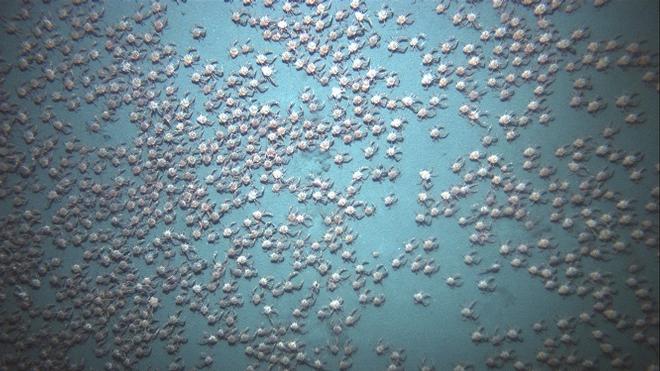Research team captures unique video of red crabs swarming
by WHOI on 15 Apr 2016

After the sub dive, the team used the SeaBED-class vehicle Jaguar AUV to gather additional images and data on the density of the crab swarm Jesús Pineda / Yogesh Girdhar / WHOI
A research team studying biodiversity at the Hannibal Bank Seamount off the coast of Panama has captured unique video of thousands of red crabs swarming in low-oxygen waters just above the seafloor.
Jesús Pineda, a biologist at Woods Hole Oceanographic Institution (WHOI) and chief scientist on the cruise, called the encounter unexpected and mesmerizing. The researchers describe their findings in a paper published April 12, 2016, in the journal PeerJ.
The team, which included colleagues from Point Loma Nazarene University, San Francisco Estuary Institute, and Smithsonian Tropical Research Institute, was working aboard the M/V Alucia. They captured the video of the crab swarm during a dive in the manned submersible Deep Rover two on the last diving mission of the month-long expedition in April 2015.
'When we dove down in the submarine, we noticed the water became murkier as we got closer to the bottom,' said Pineda, lead author of the paper. 'There was this turbid layer, and you couldn't see a thing beyond it. We just saw this cloud but had no idea what was causing it.'
'As we slowly moved down to the bottom of the seafloor, all of the sudden we saw these things,' he continued. 'At first, we thought they were biogenic rocks or structures. Once we saw them moving—swarming like insects—we couldn't believe it.'
The crabs were later identified by DNA sequencing as Pleuroncodes planipes, a species abundant in Baja California and found in the waters off the west coast of Baja California, Gulf of California, and the California Current.This documentation represents a new southernmost range of distribution for the species.
'No one had ever found this species that far south,' Pineda said. 'To find a species at the extreme of their range and to be so abundant is very unusual.'
The large aggregation of swarming red crabs was observed along the Northwest flank of the Hannibal Bank Seamount at depths of 355 to 385 meters (approximately 1,164 to 1,263 feet) in an area of 'hypoxic' (low oxygen level) water.
'These crabs have been detected before in similar low oxygen conditions,' Pineda said. 'It could be that these low oxygen waters provide a refuge for this species from predators.'
Also known as tuna crabs because they are favored prey for yellowfin tuna, Pleuroncodes planipes are an important food source for a variety of other fish, birds, and marine mammals. They migrate up and down in the water column, which also makes them vulnerable to changing currents.
A few months after the expedition, thousands of red crabs washed ashore onto Southern California beaches during a massive stranding associated with El Niño warming conditions. The researchers wondered if they were the same species as the Hannibal red crabs. After obtaining samples from a beach in San Diego in June 2015, DNA analysis revealed that the Panamanian and the Californian crabs are in fact the same species.
Seamounts are ecological 'hotspots' that are home to thriving communities of unique species. Because less than one percent of these underwater mountains have been studied, the mechanisms that make them so biologically productive are not well understood.
The focus of the Panama expedition was to learn more about both the biological and physical processes that make Hannibal Seamount such a rich ecosystem. An interdisciplinary team onboard included physical oceanographers, biologists, software scientists, and robotics engineers. Two manned submersibles were utilized to obtain biological samples, while the autonomous underwater vehicle (AUV) Seabed and the autonomous surface vehicle Jetyak were used for mapping and imaging along the seamount, and for obtaining measurements of currents.
'This study is an example of how we can effectively use the multiple tools now available to study the deep-sea habitat,' said Walter Cho, a biologist at Point Loma Nazarene University and coauthor of the paper. 'The fact that we could combine the use of submersibles to explore, observe and sample, and then use an AUV to follow-up those observations of the crab aggregation and get quantitative data is really powerful.'
The researchers plan to return to the Hannibal Seamount to further study why seamounts support such high levels of biodiversity. In addition, the deep-water areas of Hannibal Seamount, which lack dissolved oxygen and are acidic, give scientists an opportunity to investigate how communities might look in the future as the ocean responds to climate change.
Additional coauthors are Rusty Holleman of San Francisco Estuary Institute, Héctor M. Guzman of Smithsonian Tropical Research Institute, and Victoria Starczak, Annette Govindarajan, Yogesh Girdhar, James Churchill, Hanumant Singh, and David Ralston of WHOI.
Funding for this project was provided by a grant to WHOI from the Dalio Ocean Initiative.
See more here.
If you want to link to this article then please use this URL: www.sail-world.com/143781